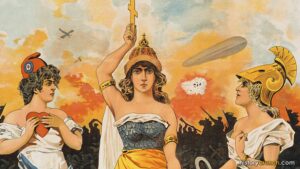The water frame, invented by Richard Arkwright in 1769, revolutionized textile manufacturing during the Industrial Revolution by harnessing water power to spin cotton fibers into strong, consistent threads. This innovation significantly increased production capacity and efficiency compared to earlier manual methods, leading to the establishment of large-scale factories. Arkwright’s water frame paved the way for the mass production of textiles, contributing to the rapid growth of the industry and the broader economy. Additionally, it played a crucial role in the shift from manual labor to mechanized production, marking a key milestone in the Industrial Revolution.
INNOVATIONS IN THE INDUSTRIAL REVOLUTION
The Industrial Revolution is one of the most significant events in all of world history and had a profound impact on the modern world. It began first in Britain in the 1700s but soon expanded to the rest of Europe and North America. Before the innovations of the Industrial Revolution, most production depended on water, wind or human energy. The businesses that existed at this time were called cottage industries. Cottage industries were an early stage of economic development in society in which workers produce a limited amount of goods in home-based businesses. However, by the mid-1700’s, new methods of production were being developed across Europe, especially in Great Britain. This transition led to the factory system, which was the creation of factories in centralized locations such as industrial towns and cities. This period of innovation continued throughout the 19th century and led to many new inventions by now famous inventors. In fact, one of the key features of the Industrial Revolution is the development of new inventions that led to more automation by machines. Significant inventions or innovations of the Industrial Revolution included: flying shuttle, spinning jenny, power loom, water frame, cotton gin, steam engine, telephone, light bulb, automobile, assembly line production and interchangeable parts.
INVENTION OF THE WATER FRAME BY RICHARD ARKWRIGHT
A significant invention of the Industrial Revolution was the water frame, which was invented by Richard Arkwright in 1769. Richard Arkwright was an English inventor and is remembered today for inventing the spinning jenny, which was important to the textile industry in England. The textile industry was based on the development of cloth and clothing in factories.
As stated above, Richard Arkwright developed a spinning machine, called a water frame, which could produce strong yarn. The machine replaced the need for manual labor and enabled the production of inexpensive spun cotton by using the moving force of a creek or river that spun a shaft. The machine was important at the time because cotton was used for clothing and other everyday items. At first, the machine was referred to as a ‘spinning frame’ but in later years, it was known as a water frame. In fact, the water frame was a major advancement over previous types of machinery including James Hargreaves’ spinning jenny. This was because the water frame essentially mechanized all of the process of spinning the yarn and required very little human labor. Arkwright’s design proved significant to the textile industry in England and was replicated all over the country. As the Industrial Revolution progressed, Arkwright’s water frame was used in countless number of factories and made his an incredibly wealthy man.


